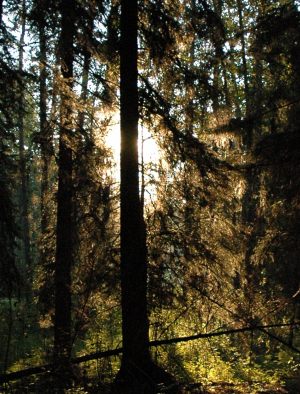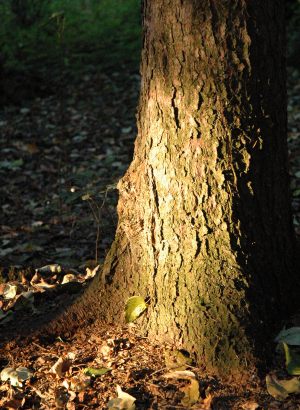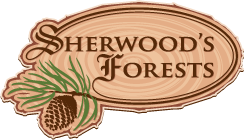
Often in summer I'll start my day with a wander. Sometimes I take my camera, sometimes my morning coffee. One August morning I was in a spruce grove and caught this picture of the early morning sun. My forest, my world.
We believe...
We are stewards, not owners
Am I a tree hugger? You bet! Not that I will stand in the way of what needs to be done. But I do believe that trees and forest enrich our lives. We will all be vastly poorer when the only trees are ones raised as a crop.
In the long run, they enrich our wallets too. Variety is the key to stability in both economies, and in ecologies. Just as you should diversify your portfolio, just as a farmer will diversify his operations, so you should diversify your land.
Trees have a huge impact: They slow the wind, creating microclimates. They accumulate snow. They provide food and shelter for all sorts of critters. Ecologists claim that edges between regions are more productive than either region is.
I believe . . .
...we have an obligation to use it responsibly, to protect it from harm, to make it more fruitful, richer in diversity.
How does this translate into action?
Most of our land is under permanent cover of some form, either trees or pasture. When I arrived, the soil was rather thin, and had little organic matter. In spring the runoff was the colour of chocolate milk. My soil was running away to the sea.
For years now , I've refrained from harvesting the pasture, in an attempt to build up the organic matter and to reduce the runoff during the spring melt. This seems to be working. During my first spring here, the pond filled overnight, and the culvert under the access road wasn't even dripping after a week. By 2012 pond day was really pond weekend, and the culvert was running (ok, trickling) for over a month. In 2015, after a heavy snow fall year, it was just barely dripping in August. 2019: It never stopped flowing until it froze. Admittedly, it wasn't flowing fast -- maybe equivalent to half on garden hose.
As a steward of this land, I have found that even with care, herbicides and insecticides always seem to have undesirable side effects. They have their place, but as I learn more I use less of these chemicals. Every tree comes with a free dandelion...
Ever since I was a boy, I've had an ongoing love affair with trees. This patch of land Laura and I call home came with several types of forest. Not content with this, I have started growing more trees, partly for my own use in making new forests, and partly for resale to others with an interest in trees. We now have dogwood, buckthorn, green ash, choke cherry, Siberian crabapple, usurian pear, and villosa lilacs that weren't present when we arrived. Lodgepole pine, concolor and veitch firs are in our front yard

I never would have imagined 10 years ago that I would wake up at 6 a.m. without an alarm clock. During the bright half of the year that's what happens. Dawn and sunset are the extra magic times. Often at sunset, I'm too pooped to enjoy it -- or at least to go get my camera for it.
I believe that the more kinds of trees, plants, birds and bugs you have on a chunk of land, the more stable it will be to various disruptions, such as pollution and climate change. This seems to be working. While I have weed problems, I have few pest problems.
I believe that being willing to share is a big part of working easily with the land. If it's "all mine" I will be disappointed. If I leave the hay on the field, the deer prefer that to eating my trees. Oh, they still nibble, but I don't lose whole trees.
Working with systems works better. My straw bale pens make wonderful homes for mice. But the mice seem to limit themselves to rummaging around the space between the pots, and don't come up to chew on the trees. To keep the population reasonable, I keep the grass around the pens mowed often enough that there are few seeds for them to eat.
It may help that I have two pairs of nesting ravens nearby, a bunch of red-tailed hawks, and at least two kinds of owls.
We feed the birds throughout the year. I figure that a bird well fed coming into the stress of spring and breeding is more likely to succeed in raising a brood of hungry mouths. Sure, the squirrel occasionally comes by and stuffs his face. The birds wait patiently, or graze elsewhere until he's done. Except the bluejays. They will come in and argue with the squirrel over possession.
Our second summer here we put in a pond. With the pond the number and kinds of birds
increased. The mosquito population dropped. If you're a bug eating my trees, watch out! The chickadees, creepers,
nuthatches, and swallows are on the prowl.
Got something to say? Email me: sfinfo@sherwoods-forests.com
Interesting? Share this page.
Want to talk right now? Call me: (8 am to 8 pm only, please) 1-780-848-2548
Do not arrive unannounced. Phone for an appointment. Why? See Contact & Hours That same page gives our hours of operation.
Back to Top
Copyright © 2008 - 2021 S. G. Botsford
Sherwood's Forests is located about 75 km southwest of Edmonton, Alberta. Please refer to the map on our Contact page for directions.
